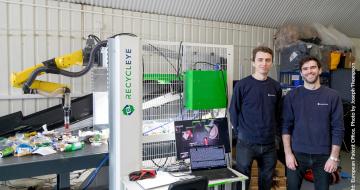The European Green Deal is a set of policy initiatives proposed by the European Commission in December 2019 to make Europe climate neutral, i.e. to reduce net greenhouse gas emissions to zero by 2050. Its goal is to make the Union’s economy sustainable, turning climate and environmental challenges into opportunities and ensuring a fair and inclusive energy transition.

The Commission insists on how important it is, in order to implement this Green Deal, to rethinking policies on clean energy supply for the whole economy, industry, production and consumption, major infrastructure, transport, on food, agriculture, construction, taxation and social benefits.
In March 2020, the Commission adopted an EU industrial strategy to address the twin challenge of the green and the digital transformation. The projects listed below aim at achieving the strategic objectives of European Union’s new industrial policy :
- Draw up a Single Market Enforcement Action Plan.
- Draw up an SME Strategy for a sustainable and digital Europe.
- Evaluate, review and, if necessary, adapt EU competition rules as of 2021, including the ongoing evaluation of merger control and fitness check of State aid guidelines.
- Draw up an Intellectual Property Action Plan to assess the need to upgrade the legal framework, ensure a smart use of IP, better fight IP theft.
- Follow-up to the European Data Strategy to develop an EU data economy, including the launch of common European data spaces in specific sectors and value chains.
- Update and strengthen the legal framework for a single market in digital services via the Digital Services Act.
- Draw up a Circular Economy Action Plan adopted in parallel with this strategy, including a new sustainable product policy framework
- Empower consumers to play an active role in the circular economy, through better product information and improved consumer rights.
- Draw up a Digital Education Action Plan.
- Follow-up to the 5G Communication and the Recommendation on cybersecurity of 5G networks.
- Draw up a new EU pharmaceutical strategy in 2020, including actions to secure supplies and ensure innovation for patients.
The Commission states in its Intellectual Property Action Plan that European innovators are pioneers in the field of green technologies. They possess large intellectual property portfolios in technologies such as climate change adaptation, carbon capture and storage, as well as water and waste treatment. The Commission also stresses that IP regulation must meet the needs of the new green economy. This action plan is an initiative proceeding from the new European industrial strategy, which states the need for the EU to have an intellectual property policy that contributes to preserving and strengthening the European technological sovereignty.
Innovation appears to be essential to ensure and accelerate the energy transition. In this context, the intellectual property’s role is to encourage innovation and foster R&D with a view to finding solutions which make it possible to stimulate a competitive and low-carbon economy by 2050. The intellectual property framework should be used to serve the objectives of better controlling production costs and reducing the energy intensity of production and consumption processes. In this context, some international institutions in the field of intellectual property have undertaken various initiatives, striving towards the same objectives and complementary, in the field of green innovation or technologies. Here is a non-exhaustive overview of these initiatives
European Patent Office (EPO)
In November 2018, the EPO identified climate change as one of the most pressing problems facing the planet, threatening our environment, livelihoods and economies. Innovation can provide answers to the challenges proceeding from climate change. In fact, numerous sustainable technologies leading the way in mitigation and adaptation. originate from patents granted by the EPO. These include new designs for turbines, inspired by nature and which save energy, innovative ways to store harmful gases, and appliances that use less water.
Patents are therefore crucial to encourage investment in sustainable technologies and to support their spread throughout global markets. Patent information is also instrumental as it allows inventors to build upon, and improve, existing technology. It gives researchers the tools they need to develop new solutions to mitigate and take account of climate change. The EPO developed the so-called “Y02” patent classification scheme which covers technologies for mitigation or adaptation against climate change. It provides free of charge the public with information enabling them to follow up the evolution of green technologies on a global scale. This specific classification key for climate protection technologies (“Y02 patents”) makes it possible to search “green” inventions in the Espacenet patent database (https://www.epo.org/news-events/in-focus/classification.html)
Also, the EPO has set up collaborations with various institutions with a view to promoting innovation in sustainable energy technologies. It cooperates with the United Nations Environment Programme (UNEP) to identify and measure inventions that could contribute to climate change mitigation. The collaboration with the International Renewable Energy Agency (IRENA) aims at ensuring wide dissemination of information on “green patents”. The EPO and the International Energy Agency (IEA) have started cooperating recently with a view to publishing a series of joint studies aimed at informing decision makers and the public of technological trends in key areas for energy transition and climate change mitigation.
Already in 2009, the EPO, the United Nations Environment Programme (UNEP) and the International Centre for Trade and Sustainable Development (ICTSD) joined forces to study the role of the patent system in the field of climate change technologies, with a view to giving insights to build an informed debate on.
A first study on clean energy patents and technologies was published in 2010. It was followed by three studies at regional level – on Africa (2013), Latin America (2014), Europe (2015) – conducted by the EPO and UNEP:
The EPO published the following recent reports:
- Sustainable technologies: Building a better future with “green” patents
- Climate change mitigation technologies in Europe
- Innovation in batteries
World Intellectual Property Organization (WIPO)
The World Intellectual Property Organization (WIPO) also contributes towards achieving sustainable development goals by providing concrete services to its member states, enabling them to use the intellectual property (IP) system to achieve objectives such as ensuring access to affordable and reliable energy for all, building resilient infrastructure and sustainable industrialization, or ensuring sustainable consumption and production patterns.
WIPO’s sustainable development goal no. 9, Industry, Innovation and Infrastructure, offers a series of programs, platforms, projects and activities that help Member States create an enabling environment for innovation and creativity, that is key to designing integrated solutions to address the sustainable development challenges.
In addition, the WIPO’s Development Action Plan is intended to integrate development-related issues into the organisation’s work.
Finally, the following WIPO initiatives should be noted:
- The “IPC Green Inventory” which has been developed to facilitate searches for patent information relating to Environmentally Sound Technologies (ESTs), as listed by the United Nations Framework Convention on Climate Change (UNFCCC).
- WIPO GREEN is an online technology exchange platform aimed at connecting providers and seekers across the world . It supports global efforts against climate change by connecting suppliers and seekers of environmentally friendly technologies. Through its database, network and acceleration projects, it brings together the main players in order to catalyse innovation and the dissemination of green technologies;
- The WIPO website proposes to follow webinars to learn more about the central role of innovation and intellectual property in building a green future
European Union Intellectual Property Office (EUIPO)
The EUIPO Strategic Plan 2025 is based on three powerful drivers, which will drive its work and activity over the next five years: an interconnected, efficient and reliable IP System for the Internal Market, advanced customer-centric IP services and dynamic organisational skill sets and an innovative workplace of choice. Strategic Driver 3 (SD3), IP innovation, includes initiatives dedicated to SMEs, in particular regarding domain names, educational resources to make the most of intellectual property, and rights enforcement resources.


